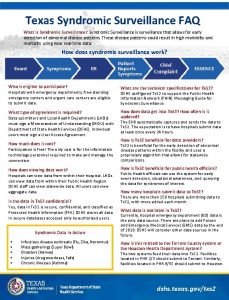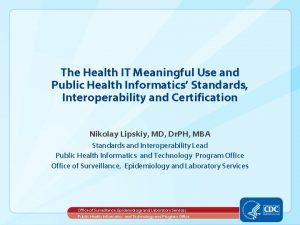Texas Syndromic Surveillance FAQ What is Syndromic Surveillance

- Slides: 1

Texas Syndromic Surveillance FAQ What is Syndromic Surveillance? Syndromic Surveillance is surveillance that allows for early detection of abnormal disease patterns. These disease patterns could result in high morbidity and mortality using near real-time data. How does syndromic surveillance work? Who is eligible to participate? Hospitals with emergency departments, free-standing emergency centers and urgent care centers are eligible to submit data. What are the technical specifications for Tx. S 2? DSHS configured Tx. S 2 to support the Public Health Information Network (PHIN) Messaging Guide for Syndromic Surveillance. What type of agreement is required? Data submitters and Local Health Departments (LHDs) must sign a Memorandum of Understanding (MOU) with Department of State Health Services (DSHS). Individual users must sign a User Access Agreement. How does data get into Tx. S 2? How often is it updated? The EHR automatically captures and sends the data to Tx. S 2. The expectation is to have hospitals submit data at least once every 24 hours. How much does it cost? Participation is free! The only cost is for the information technology personnel required to make and manage the connection. How does viewing data work? Hospitals can view data from within their hospital. LHDs can view data from within their Public Health Region. DSHS staff can view statewide data. All users can view aggregate data. Is the data in Tx. S 2 confidential? Yes, data in Tx. S 2 is secure, confidential, and classified as Protected Health Information (PHI. ) DSHS stores all data in secure databases accessed only by authorized users. Syndromic Data in Action § § § Infectious disease outbreaks (flu, Zika, Norovirus) Mass gatherings (Super Bowl) Disasters (Harvey) Injuries (drug overdoses, falls) Chronic illnesses (Asthma) How is Tx. S 2 beneficial for data providers? Tx. S 2 is beneficial for the early detection of abnormal disease patterns within the facility and uses a proprietary algorithm that allows for statewide comparisons. How is Tx. S 2 beneficial for public health officials? Public Health officials can use the system for early event detection, situational awareness, and querying the data for syndromes of interest. How many hospitals submit data to Tx. S 2? There are more than 250 hospitals submitting data to Tx. S 2, with more added each month. What data is available in Tx. S 2? Currently, hospital emergency department (ED) data is the only data source. There are plans to add Poison and Emergency Medical Services (EMS) data by the end of 2019. DSHS will consider other data sources in the future. How is this related to the Tarrant County system or the Houston Health Department system? The two systems feed their data into Tx. S 2. Facilities located in PHR 2/3 should submit to Tarrant. Similarly, facilities located in PHR 6/5 S should submit to Houston. dshs. texas. gov/txs 2

